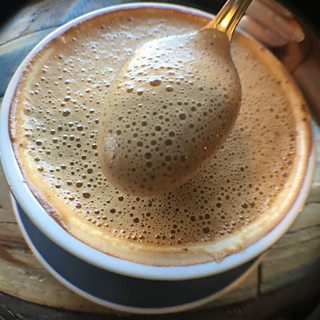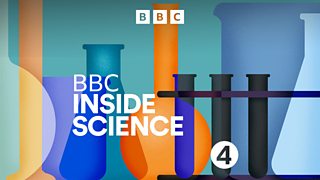Can bubbles save the planet?
In the first episode of the new series of Curious Cases, hosts Hannah Fry and Dara Ó Briain get to grips with the slippery genius of bubbles.
Their journey starts with listeners Abi and Sofia who wonder, after seeing videos of people inside of bubbles, if it was possible to cover the Earth with a giant bubble to combat climate change.
As Hannah, Dara and their guests discover, the link between bubbles and environmental action isn’t as airy a notion as it might at first seem.

Listen to Space Bubbles on 成人快手 Sounds
a kind of soupy liquid that is able to stretch ridiculously fast without breaking
Giant bubbles have a secret ingredient
The majority of bubbles are simply a mix of soap and water, and they will only ever provide fleeting and modestly-sized bubbles because the surface tension of the water will always pull them in and pop them.
Bigger and more durable bubbles are possible if the bubble mix includes an added ingredient – guar gum. Guar gum is made from a seed grown in India and, when powdered and soaked in water, its carbohydrate molecules (polysaccharides) form long chain polymers. If these polymers are added to a soap bubble mix they turn it into what Dr Justin Burton, a physicist at Emory University in Atlanta, describes as “a kind of soupy liquid that is able to stretch ridiculously fast without breaking.”
Testifying to the power of guar gum, some of the bubbles that Dr Burton has made were stable enough to poke a finger through and were large enough to enclose his young son!

Bubbles last longer in zero gravity
NASA has experimented with bubbles in their space stations and observed that, because of zero gravity, the water part of the bubble doesn’t drain away as it normally would, and so the liquid layer of a bubble can be thicker. The thicker bubble walls mean that it’s possible to create different coloured bubbles using food dye – something that would not be possible otherwise.
Outside the space station, however, as Dr Helen Czerski, Associate Professor at the Department of Mechanical Engineering at UCL, explains, “gas just disappears”.
“There's nothing to stop it,” Helen explains: “No humidity, nothing bouncing on it to keep it in – the bubbles evaporate incredibly quickly.”
A bubble layer the size of Brazil
Despite the scenario Helen describes above, the Massachusetts Institute of Technology (commonly known as MIT) is actually looking at using bubbles in space to provide a “Plan B” for Earth in the face of its rising temperatures. Led by Professor Carlo Ratti, the initiative – literally named Space Bubbles – involves using an “umbrella” of bubbles more or less the size of Brazil placed between the Earth and the sun. According to the professor, the thinking is that this “maximal surface with minimum thickness” would “reflect a small percentage of the sunlight incoming on the planet”. The percentage of sunlight reflected could be as little as one to three percent but, according to Professor Ratti, that would be enough to cool down the Earth.

A foam party like no other
The bubble umbrella idea naturally inspires a lot of discussion between Hannah, Dara, Helen and Justin.
Helen wonders about the maintenance of the umbrella and if it could be knocked off course by a passing meteorite, for example.
Justin takes some inspiration from the foam machines used at various parties for adults and children. “I can imagine a bubble machine sitting out there in space constantly pumping out this foam until it's the size of Brazil,” he says. “I don't think it's impossible to get the biggest bang for the buck in terms of reflecting light and having the least amount of material possible.”
Why a caffè latte reveals the power of bubbles
Hannah gives the bubble umbrella idea more credence when she mentions that the mix would involve a silicon polymer and “a very, very, very, very, very small amount of gas.” She adds: “The idea is that these things just freeze. It's a bit like when you go in your garden in the dead of winter and you blow bubbles and they freeze, like that but just in space.”
Meanwhile, Helen warms to the idea and notes that “bubbles are interesting because they're a liquid and a gas not mixing, and together they can do things that neither one of those things can do on their own.” She uses the example of a caffè latte to illustrate this: “You have the liquid and the gas together in the right form – foam – and that can take the weight of a spoon.”

More science from Radio 4
-
![]()
The Infinite Monkey Cage
Brian Cox and Robin Ince host a witty, irreverent look at the world through scientists' eyes.
-
![]()
The Life Scientific
Professor Jim Al-Khalili talks to leading scientists about their life and work
-
![]()
Curious Cases
Hannah Fry and Dara 脫 Briain tackle listeners' conundrums with the power of science!
-
![]()
成人快手 Inside Science
A weekly programme that illuminates the mysteries and challenges the controversies behind the science that's changing our world.




